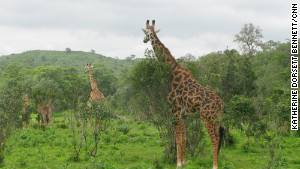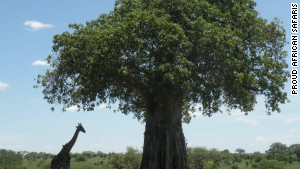The country's bountiful
wildlife, vast array of landscapes, relatively safe environment for
tourists and temperate climate near the equator make Tanzania a
desirable year-round destination for a safari. You just need a
knowledgeable guide to help you make the most of the seasonal patterns
of the animals while you're there.
For the best experience,
most travel experts suggest planning and booking your trip with a safari
operator, and it's worth your time to obtain quotes, research and
compare differences between a few of them before deciding.
Accommodations in
Tanzania can range from high-end luxury lodges and tented camps to
mid-range and budget lodges or basic camp sites. Mid-range lodges in
Tanzania may cost on average $350 to $700 per night for a double room
and upscale operations may run visitors between $750 and $3,000 per
night.
The most popular
Tanzanian safari destinations are in the north, in what's commonly
referred to as the northern game circuit. Here are five stunning parks
to explore:
Arusha National Park
Size: 52.9 square miles

Arusha National Park has a large variety of wildlife, including giraffes.
The northern town of Arusha is considered the gateway to the northern game circuit. Nearby Arusha National Park
might be small by Tanzanian standards, but it's filled with animal life
covering three distinct areas: the Momela Lakes, Ngurdoto Crater and
the rugged Mount Meru.
The park is famous for its 400 species of birds, said Nandi O'Dell, a Tanzanian safari specialist with Proud African Safaris.
The lakes particularly attract pink-hued lesser flamingos. The Ngurdoto
Crater is surrounded by steep, rocky cliffs and often filled with herds
of buffalo and warthogs roaming the swampy ground. Mount Meru is
covered with lush forests and bare rocks.
Arusha is the only place
on the northern safari circuit where you can easily find a black and
white colobus monkey. You are fairly certain to spot giraffes, zebras,
hippos, leopards, elephants, baboons, buffalos and hyenas, too. "Lions
are absent from this park since they need a larger territory for hunting
and can't thrive like they do in bigger parks," noted O'Dell.
Accommodations: Try the midlevel Arumeru River Lodge or the upscale Lake Duluti Lodge.
Lake Manyara National Park
Size: 127 square miles
Ernest Hemingway once called Lake Manyara National Park "the loveliest" in Africa.
Some 77 square miles of
the park's 127 square mile area are covered by the alkaline Lake Manyara
when water levels are high. A lush forest in the park is home to
baboons and blue monkeys, among other wildlife. The acacia woodland is a
favorite spot for tree-climbing lions, a behavior that is not common in
most places in Africa, said O'Dell. The Rift Valley escarpment, which
towers 1,968 feet, provides a striking backdrop to the lake.
The trail inside the
park is a huge loop that O'Dell says can be navigated by a safari truck
within a couple of hours. You're likely to spot baboons, giraffes,
hippos, elephants, wildebeests, impalas, buffalo, warthogs, dik-diks and
flamingos along the way.
Accomodations: Explore the mid-level Plantation Lodge or try the high-end Manor at Ngorongoro.
Ngorongoro Conservation Area
Size: 3,205 square miles
This region has often been described at the "eighth wonder of the world" and is a UNESCO World Heritage Site. The main feature of Ngorongoro Conservation Area
is the Ngorongoro Crater, the world's largest unbroken volcanic
caldera. The 2,000-foot-deep crater formed when a volcano exploded and
collapsed on itself some 2 to 3 million years ago. A rich grassy pasture
covers the crater floor and provides favorable conditions for grazing
animals such as lions, zebras, gazelles, buffalo and warthogs, to name a
few.
"This natural enclosure provides a safe haven for some of Tanzania's endangered black rhinos," O'Dell said.
Accomodations: Try the mid-level Ngorongoro Serena Safari Lodge or the luxury the luxury Ngorongoro Crater Lodge.
Serengeti National Park
Size: 5,700 square miles
The Serengeti
is Tanzania's largest, and perhaps most famous, national park. The
seemingly endless grassy plains are host to the famous Great Migration
-- the largest mass movement of hooved animals on the planet, said
O'Dell. More than 1.4 million wildebeest, 250,000 zebras and 400,000
Thomson's gazelles annually migrate in a clockwise direction over 1,800
miles in an endless search for food and water.
This park also boasts
some 9,000 hyenas, 2,800 lions, 1,000 leopards and 500 cheetahs. O'Dell
said these statistics can fluctuate on a yearly basis, but these numbers
are fairly consistent estimates. The name Serengeti comes from the
Maasai language and means "endless plains."
Accomodations: Stay at the mid-level Mbuzi Mawe Luxury Tented Camp in the central region of the Serengeti or or the high-end Serengeti Bushtops in the northern extension of the Serengeti.

Tarangire National Park is famous for its baobab trees.
Tarangire National Park
Size: 1,100 square miles
This natural wonder is
named after the Tarangire River that flows through the park and provides
the only permanent water for wildlife in the area. This national park is
famous for its large population of elephants and more than 550 species
of birds. These creatures are among the fauna that roam the park's
grounds, which are dotted with baobab trees, acacia woodlands, high
grasses and seasonal swamps.
Accommodations: Try the mid-level Kikoti Luxury Tented Camp or the high-end Tarangire Treetops Lodge.
No comments:
Post a Comment